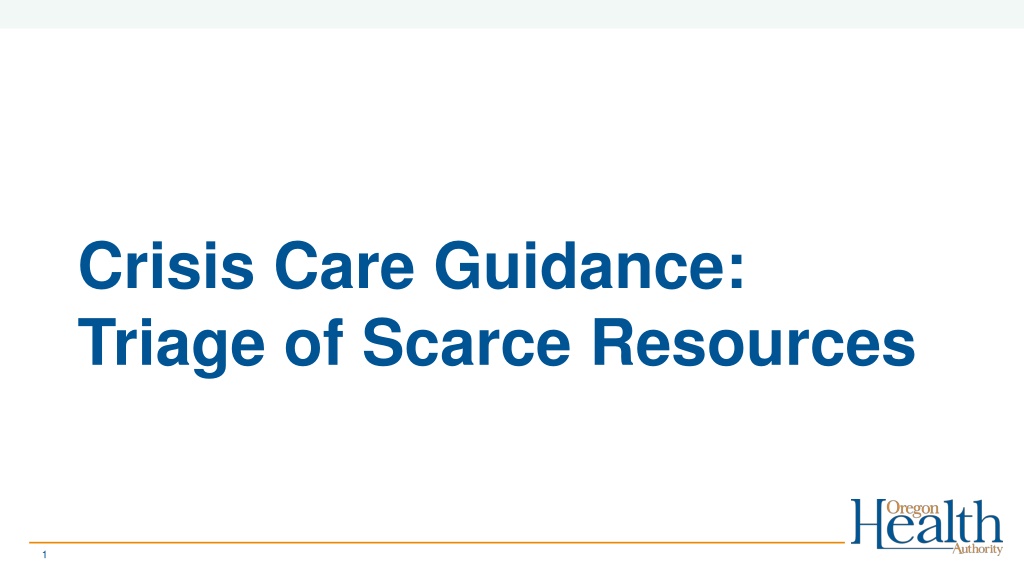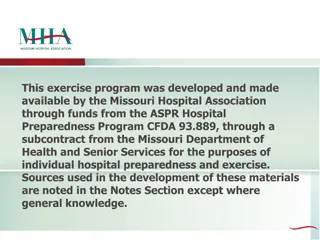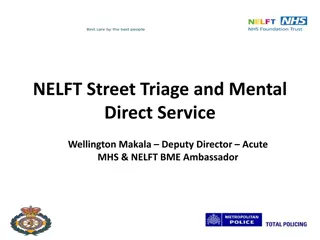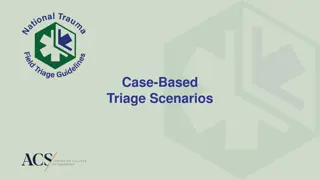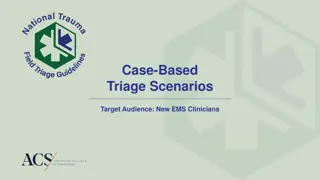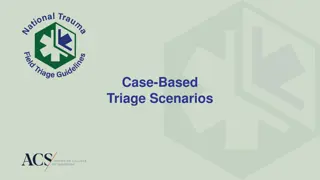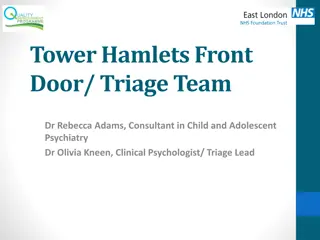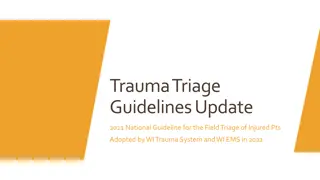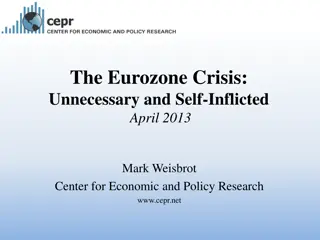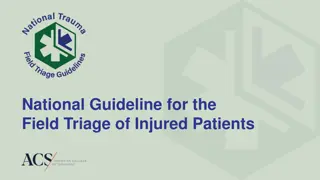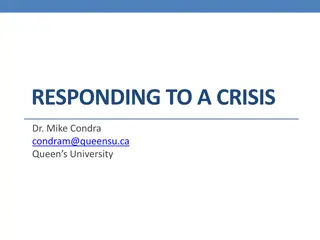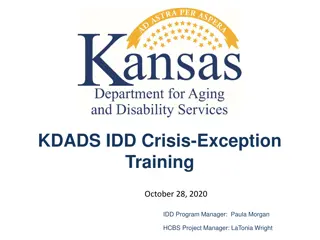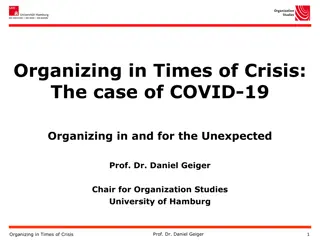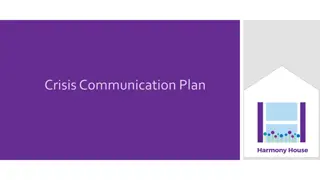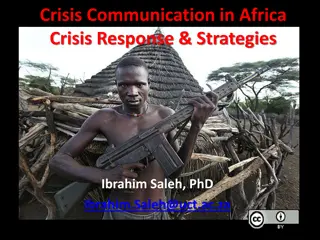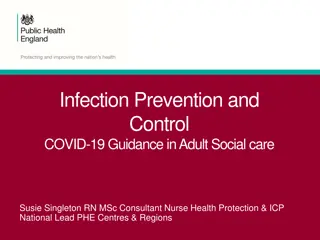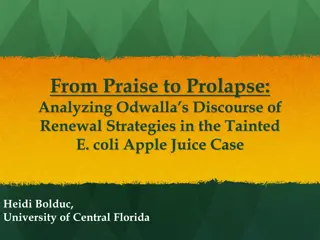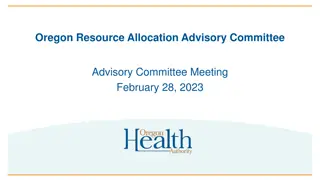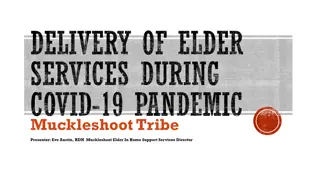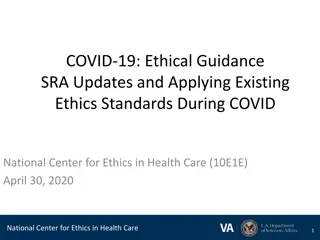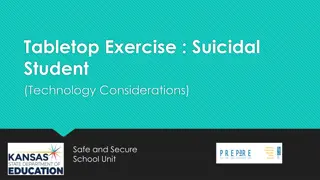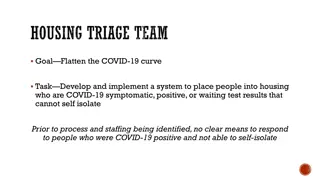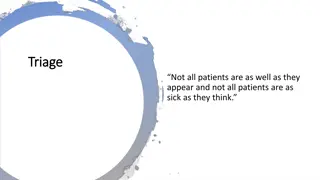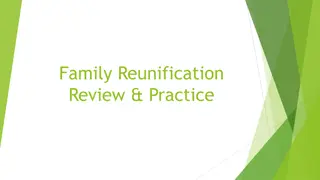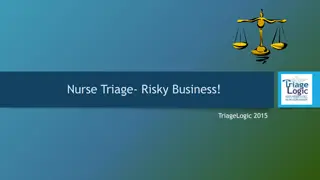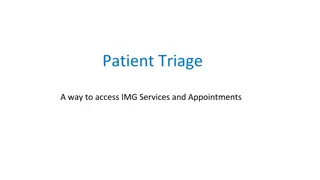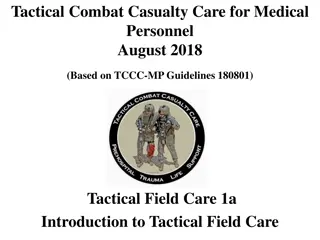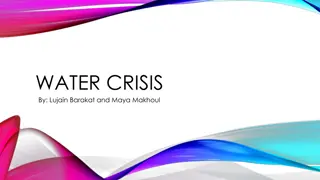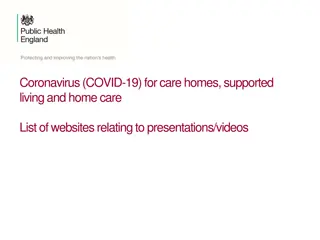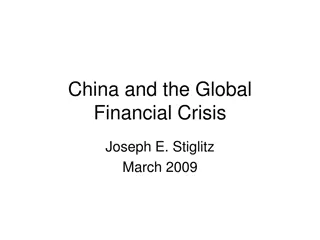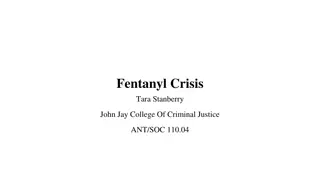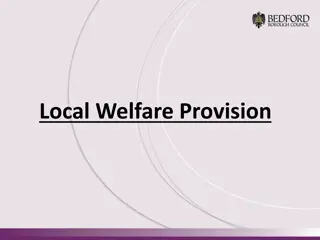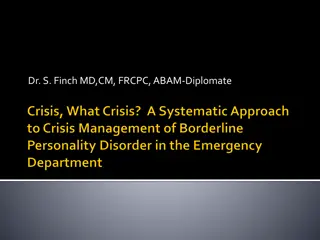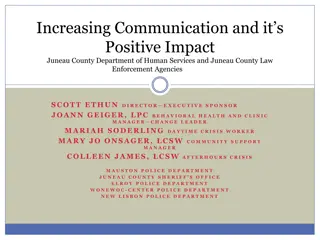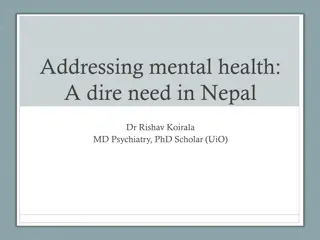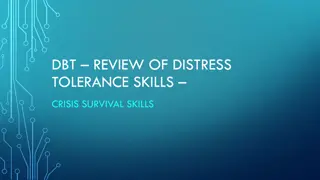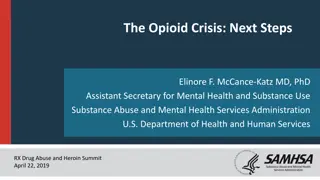Crisis Care Guidance and Triage of Scarce Resources
Crisis care guidance focuses on providing health care differently during emergencies, such as public health crises or disasters, when resources are overwhelmed. Triage frameworks help prioritize scarce resources to protect communities and reduce health inequities. Oregon's approach aims to allocate resources fairly, considering community input and cultural values. Commitments include promoting public health, procedural justice, and prioritizing input from communities facing health inequities.
Download Presentation

Please find below an Image/Link to download the presentation.
The content on the website is provided AS IS for your information and personal use only. It may not be sold, licensed, or shared on other websites without obtaining consent from the author. Download presentation by click this link. If you encounter any issues during the download, it is possible that the publisher has removed the file from their server.
E N D
Presentation Transcript
Crisis Care Guidance: Triage of Scarce Resources 1
Review ORAAC Triage Approaches Subcommittee Discussions 2
Crisis Standards of Care and Guidance Crisis standards of care is health care that is provided differently than during normal operations. These changes are necessary due to a crisis, such as a widespread public health emergency or overwhelming disaster. Crisis care guidance describes how a community or health care system should respond when resources are overwhelmed. Any crisis care triage framework to determine who is prioritized for a scarce resource should be flexible to work in range of emergency situations (respiratory pandemics; large scale environmental disasters). 3
Overarching Priority/Goal OHA has been clear in its priority to reduce health inequities as part of its published crisis care guidance during the pandemic as well as in gathering and supporting the Oregon Resource Allocation Advisory Committee (ORAAC). Our task is to set out rules that guide who receives scarce, life-saving resources when there is not enough for everyone who needs them. The goal of our approach to allocating resources is to protect the health of communities in Oregon and to reduce health inequities and the disadvantage caused by oppression. 4
Commitments We will center hope and innovation in our work and not be limited by current practices or known options for triage. We will work to promote public health and achieve procedural justice through transparency, seeking community input on emerging recommendations, assessing local cultural values regarding resource allocation, considering this information as part of recommendation development and addressing concerns that arise. We will prioritize input from communities who face the greatest health inequities. 5
Crisis Standards Considerations (1 of 2) Crisis care guidance must acknowledge: There is no perfect, universally accepted or accurate approach; justification will be needed for all choices made It will be necessary to frequently evaluate chosen approaches, review data, learn and refine guidance Health systems must develop ongoing partnerships with the communities most impacted by health inequities to develop and refine crisis care guidelines and other approaches to reducing health inequities 6
Crisis Standards Considerations (2 of 2) Crisis care tools are but one part of broader efforts needed in a public health emergency necessary to protect the public and reduce inequities, including but not limited to: Emergency preparedness Broad access to culturally responsive health care and needs Access to supports that allow individuals with disability to achieve desired independence and communicate their needs and goals A diverse, responsive and supported healthcare workforce Local, regional, statewide and interstate communication Movement of patients to access needed care (e.g., load balancing ) 7
Crisis Care Triage Options For ORAAC Consideration 8
Triage Approaches Subcommittee The ORAAC Triage Approaches Subcommittee has reviewed multiple criteria that can be used for the allocation of scarce life-saving resources. The committee deliberated on justification and drawbacks for each, and explored how they might be operationalized. The subcommittee members requested that all options reviewed and considered by the full ORAAC. The following slides represent the criterion and options discussed by the committee. 9
Overview Crisis Care Triage: criteria for consideration: 1. 2. 3. 4. 5. 6. Clinician prognosis ( 90% or 10% chance for hospital survival) Equitable chances (weighted randomization based on impact) Essential worker (prioritized at individual or geographic level) Multiplier effect Life cycle principle Sequential Organ Failure Assessment (SOFA)/ Modified SOFA *As stand alone criteria or part of a multi-criteria approach OHA has significant concerns with continuing to use or using these options 10
Criterion: Clinician Prognosis (1 of 3) Clinical prognosis for patient survival to hospital discharge is determined by a triage team: A triage team including people with clinical expertise determines how likely it is for a patient to survive to hospital discharge if they receive the needed resource Clinical prognosis would impact (increase or decrease) a patient s prioritization if they have 90% or 10% chance of survival to discharge if provided the resource. Only certain clinical information regarding each patient would be available to the triage team to aid their determination of prognosis Training and considerations for prognosis determination would be developed to increase consistency across triage teams 12
Criterion: Clinician Prognosis (2 of 3) Using this criterion, patients are placed in one of several resource priority groups based on clinician prognosis for survival to hospital discharge. Example: Priority Group 1: patient has a greater than or equal to 90% chance of survival to discharge if provided the resource Priority Group 2: patient has an 11-89% chance of survival to discharge if provided the resource Priority Group 3: patient has a less than or equal to 10% chance of survival to discharge if provided the resource Priority Group 4: patients with expected imminent death or lowest likelihood of survival (to be further discussed at May subcommittee meeting) 13
Criterion: Clinician Prognosis (3 of 3) When an absolutely scarce resource exists, the order of priority for who receives that resource is determined based on the assigned priority group. For example: Priority Group 1 is first in line for resource Priority Group 2 is second in line for resource Priority Group 3 is third in line for resource Priority Group 4 would be last in line for resource If the resource runs out, additional criteria would be applied to determine prioritization within a priority group (tiebreaker) 14
Clinician Prognosis: Justification This criterion prioritizes an absolutely scarce resource (e.g., ventilator) for patients with highest likelihood ( 90%) to survive the hospital stay Also, by not allocating an absolutely scarce resource to a patient with very low likelihood to survive hospital stay ( 10%), that ventilator is available to someone more likely to survive hospital stay Evidence suggests high accuracy of clinician prognosis for survivability when prognosis for chance of survival is 90% or 10% Removes reliance on inaccurate and inequitable survivability prediction tools such as SOFA/mSOFA Opportunities to inform the triage team participants, processes and training allows for hope and innovation 15
Clinician Prognosis: Drawbacks Published research is mixed regarding the accuracy of clinician prediction of short-term survival Accuracy is lowest when intermediate levels of prognosis estimated May allow for greater provider bias and discrimination than other triage opportunities Bias and discrimination can prevent racial and ethnic minority patients, patients with disabilities, and older adults from having equal access to health care Triage team training and approach can help to limit bias and discrimination 16
Disadvantage Indices For application in Equitable Chances Criterion 17
Disadvantage Indices (1 of 2) Disadvantage indices are place-based measures that combine social factors such as income, education and quality of housing These factors are measured at a geographic level (e.g., county subdivision or neighborhood) Disadvantage indices are used to measure a geographic area s level of socioeconomic deprivation or vulnerability Individuals can be assigned a disadvantage score based on their home address These indices can be used to account for disadvantage and inequities during the allocation of scarce resource 18
Disadvantage Indices (2 of 2) Disadvantage Index Social Vulnerability Index (SVI) Area Deprivation Index (ADI) Sixteen (16) Seventeen (17) Number of Factors Measured Socioeconomic status Household characteristics Racial and ethnic minority status Housing type and transportation Census Tract (County Subdivisions) Income Education Employment Housing quality Measure Themes Census Block (Neighborhood) Geographical Level of Measurement U.S. Census Data American Community Survey Data Source U.S. Government: Centers for Disease Control and Prevention (CDC) Academic: University of Wisconsin-Madison Maintained/Validated 19
Criterion: Equitable Chances 20
Criterion: Equitable Chances (1 of 3) In this approach, a disadvantage index is used to assess disadvantage based on the patient s geographical residence This criterion then uses a weighted randomization process to determine a patient s priority for receiving a needed scarce resource. Instead of simply randomizing eligible patients to receive a scarce resource, which would not reflect that some groups are hit harder than others, the equitable chances approach provides additional weighting of chances, such that more disadvantaged groups have higher chances in proportion to the extent they have been more affected (for example, in terms of deaths). 21
Criterion: Equitable Chances (2 of 3) Approach: Using a chosen disadvantage index (e.g., SVI or ADI), the patient s home address is used to assign a disadvantage score Additional priority (beyond equal chance) is assigned for each patient if their disadvantage score has been assigned weighting For example, higher chances (weighting) added for any patient with the highest disadvantage e.g., score of 8, 9, or 10 based on the ADI (1-10 scale) A randomization process with application of equitable chances weighting proportionate to impact of disaster then determines patient prioritization for the resource 22
Criterion: Equitable Chances (3 of 3) Per input from the ORAAC s Triage Approaches Subcommittee, the disadvantage index (e.g., ADI, SVI) should incorporate: Additional up-to-date measures, when available, that capture who is most impacted by the current emergency (e.g., cases, hospitalizations, deaths) Also consider adding: Place-based measures using occupational data to capture essential workers Additional data to distinguish between differing geographic levels of disadvantage such as school districts and medical services areas 23
Equitable Chances: Justification Strong association between disadvantage indices and impact from crisis Recognizes that not everyone has the same chances for resources or survivability at baseline Removes reliance on inaccurate and inequitable survivability estimation tools (e.g., SOFA/mSOFA) Can avoid adding to existing inequities for legally protected groups Studies suggest it has least negative impact on inequities compared to SOFA only, youngest first, or multi-criteria approaches Opportunity to update disadvantage indices based on known, evolving impacts during an emergency with additional data to improve correlation with disadvantage impact 24
Example: Oregon CCVI Data 1 of 2 The Surgo Foundation s COVID-19 Community Vulnerability Index (CCVI) is based on the SVI and has expanded measures of community vulnerability specific to the spread of COVID-19 (a total of 40 variables). The Program Design and Evaluation team studied how well the CCVI predicted Oregon COVID-19 cases from February 2020 through July 2021. A total of 824 of Oregon s census tracts (of 834) had CCVI data and were studied 98.5% of Oregon s 215,272 COVID-19 cases had verifiable addresses The evaluators also studied changes in the performance of the predictive model with two additional variables: the number of adult prisons and proportion of the population who are essential workers. 25
Example: Oregon CCVI Data 2 of 2 Findings: There was a strong association between COVID-19 vulnerability based on the CCVI and Oregon COVID-19 infections by census tract. Relative to census tracts categorized as very low vulnerability, those with very high vulnerability were associated with 1.7 times the number of COVID-19 cases. There was a stepwise decrease in the number of COVID-19 cases as community vulnerability declined. The adult prison and essential worker variables were associated with higher number of COVID-19 cases and strengthened the predictive model. 26
Equitable Chances: Drawbacks Requires the development of criteria regarding: Which segment of the disadvantage spectrum should be prioritized By how much their chances should be increased 27
Occupation or Industry Related Criteria 28
Criterion: Essential Workers Priority for receiving a needed resource is given to those whose occupation meets the definition of an essential worker Typically assumes additional exposure or risk based on the occupation May include: healthcare/public health, first responders/public safety, military, public works, educators, social service providers, food production & provision, non-food manufacturing, transportation/public transport Prioritization can be achieved at the individual or geographic level Individual level: individual assessment of whether patient meets the definition of an essential worker Geographic level: occupation data collected at geographic level and included as part of a disadvantage index. 29
Essential Workers: Justification Critical for maintaining the functioning of society and essential services Can decide which occupations to include (e.g., home health workers) May vary depending on the type of emergency (e.g., nuclear power plant worker vs. health care worker) Reciprocity Some workers take more risks (e.g., exposure) on behalf of the public during an emergency; a higher priority for scarce resources is granted in response to their sacrifices Addition of geographic data regarding proportion of essential workers can improve correlation of disadvantage indices with impact 30
Criterion: Multiplier Effect Prioritizes individuals if, upon timely recovery, they have the potential to save other people s lives based on their occupation (especially in setting of a workforce shortage) Example occupations include: Certain health care workers e.g., intensive care unit staff Firefighters Police officers Emergency medical technicians (EMTs) 31
Multiplier Effect: Justification Save the most lives For example, more lives can be saved when there are available first responders or health care professionals to care for injured or ill during an emergency 32
Occupation Related Prioritization: Drawbacks Difficult to determine or confirm occupation at time of triage No single, agreed upon definition or criteria Risk for conflict of interest and bias E.g., health care providers prioritizing each other For multiplier effect, it can be difficult to predict whether the patient will recover in enough time to save other lives during the emergency Occupations with potential for a multiplier effect might vary based on the type of emergency (e.g., pandemic vs. earthquake) 33
Criterion: Life Cycle Patients in an earlier life cycle would be given higher priority for the scarce resource than patients in a later life stage Classifications for life cycle are made based on age. For example: Childhood (0-17) Early Adulthood (18-39) Middle Age (40-64) Older Adults (65+) 35
Life Cycle: Justification Patients who have not had the same opportunity to live through life stages are given priority Age is generally easy to determine and categorize into a predetermined life stage May improve health equity Can counteract the effects of unjust inequities in life expectancy across groups Demographically, life expectancy differs across racial and ethnic groups and disability. White and non-disabled people are generally growing older than communities of color and disabled people. 36
Life Cycle: Drawbacks Requires the development of life stage classifications by age No current established criteria or agreement on which life stage categories should be used for purposes of prioritization May not fully align with different cultural norms or values Can have community-wide impacts on access to cultural practices when those in later life cycles (e.g., elders) are deprioritized Prioritizing younger people (i.e., by prioritizing those in earlier life stages defined by age groupings) could be considered age discrimination Published literature and press reactions suggest mixed public acceptance; potential for significant concern if used 37
Criterion: SOFA/mSOFA 38
Criterion: SOFA/mSOFA The SOFA and mSOFA are published tools to estimate the likelihood of a patient to survive to hospital discharge These tools were originally validated for patients with sepsis Uses certain vital signs, laboratory results, and clinical assessments to determine a patient s survivability score Lower scores correlate with a higher likelihood of hospital survival Patients with the lowest scores receive the highest priority for the scarce resource during triage 39
SOFA/mSOFA: Justification Relatively easy to use Have been widely used in crisis care guidelines Many hospital teams have been trained it their use Additional modifications (or equity corrections ) may be applied in order to reduce impact on health inequities, though the impacts of these modifications have not been studied 40
SOFA/mSOFA: Significant Drawbacks Do not accurately predict short-term survival Major clinician-led consensus documents and expert reviews caution against using SOFA; several states have stopped using Not applicable to a broad range of conditions Studies showed that SOFA overestimates the survivability of white patients, and underestimates the survivability of black patients, and thus does not accurately predict survivability and increases prior inequities. May also worsen inequities for disabled people. Can be misunderstood to be resting on objective clinical data which is not true. Tool includes bias and discrimination. 41
Multi-Criteria Approaches for Consideration* Core Options Additional Stage or Tiebreaker D. Essential worker (added to disadvantage index) E. Essential worker priority F. Multiplier effect G. Life cycle A. Equitable chances alone B. Clinician prognosis + equitable chances combination C. SOFA/mSOFA + equitable chances combination *Based on ORAAC Triage Approaches Subcommittee discussion OHA has significant concerns with continuing to use or using these options 43
Option A: Equitable Chances Only (No Survivability Prognosis*) Priority for needed, scarce resource based on Equitable Chances criterion Identify home address or determine if houseless Assign disadvantage score (e.g., 0-10) Add pre-determined weighting based on that score Randomization with equitable chances weighting among all patients needing resource Results in priority order for each patient needing resource *Could consider adding some survivability consideration (such as giving secondary priority to patients whose death is imminent) 44
Option B: Clinician Prognosis + Equitable Chances Step 1: Triage Team determines prognosis for survival to hospital discharge for all patients needing resource in order to determine initial priority groupings: Priority Group 1 90% chance of hospital survival Priority Group 2 all others (e.g., 11-89% chance survival) Priority Group 3 10% chance of hospital survival Step 2: Starting with Group 1, distribute resource by equitable chances (weighted randomization) if not enough resource to serve full group; move to next group 45
Option C: SOFA/mSOFA + Equitable Chances Step 1: Triage Team applies SOFA/mSOFA (e.g., with equity corrections) to determine prognosis for hospital survival for all patients; only very high/low scores applied for prioritization Priority Group 1 mSOFA score <4 or 6 Priority Group 2 all other mSOFA scores mSOFA score > 12 or 14 Priority Group 3 Step 2: Starting with Group 1, distribute resource by equitable chances (weighted randomization) if not enough resource to serve full group; move to next group 46
Additional Prioritization Stage or Tiebreaker Options Option D: Essential Worker Added to disadvantage index as additional equitable chances weighting at a geographical level Option E: Essential Worker Option F: Multiplier Effect Option G: Life Cycle For options E-G, would be added as prioritization at the individual patient level (e.g., before equitable chances step or as additional individual weighting) 47
Example Application of Priority for Essential Workers, Multiplier Effect, and/or Life Cycle (at patient level) Step 1: Triage Team determines prognosis for survival to hospital discharge for all patients: Priority Group 1 90% chance of hospital survival Priority Group 2 all others (e.g., 11-89% chance survival) Priority Group 3 10% chance of hospital survival Step 2: Prioritize (or add priority weighting) based on: Essential worker verification, multiplier effect verification, life cycle Step 3: Tie breaker: apply equitable chances weighted randomization 48
Voting: Triage Option Preferences Goal: Identify Top ~ Three Triage Options for Public Comment Period 49
Multi-Criteria Approaches for Consideration* Core Options Additional Stage or Tiebreaker D. Essential worker (added to disadvantage index) E. Essential worker priority F. Multiplier effect G. Life cycle A. Equitable chances alone B. Clinician prognosis + equitable chances combination C. SOFA/MSOFA + equitable chances combination *Based on ORAAC Triage Approaches Subcommittee discussion OHA has emerging concerns regarding use of these options 50
